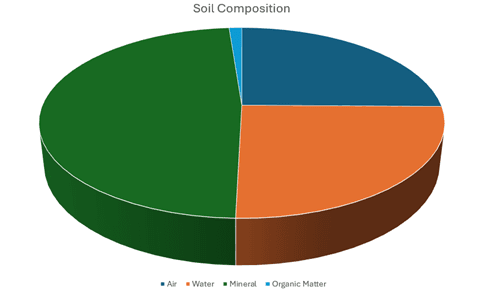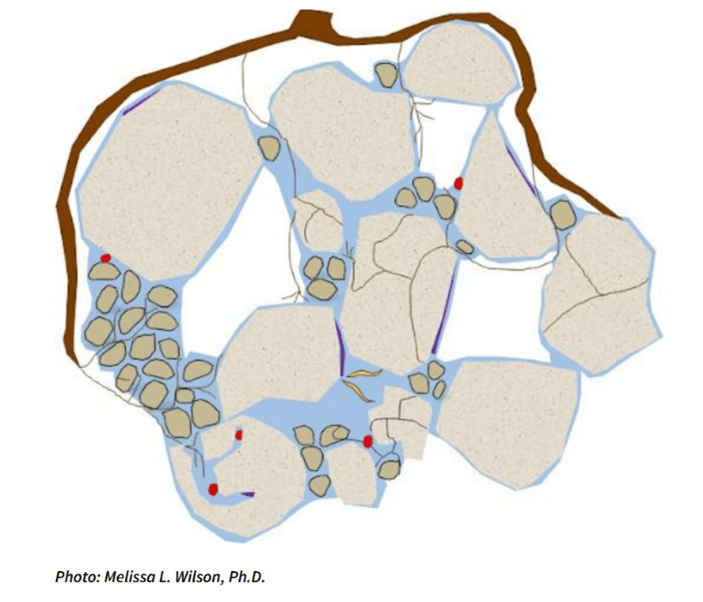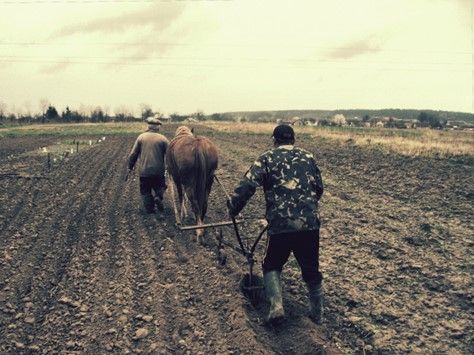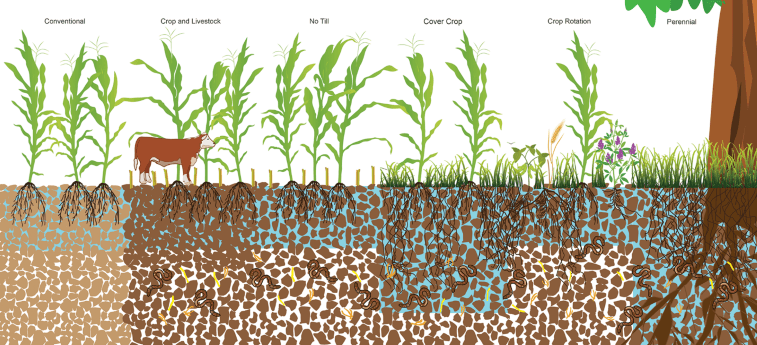What is Tillage? A history of tilling our soils and what it costs us.
What is Tillage?
From the stone tools of early humans (Some tools dating over 3 million years old) , to the ard (used as early as 5000 years ago), to the mold bore plow, humans have loved breaking up soil and creating an ideal tilth for their seeds. So, after tens of thousands, possibly millions of years of breaking up the soil to create a seed bed why are people suddenly saying No-Till, or No Tillage, is the solution?
Before we get into that let’s look at what gives soil its structure and how modern tillage effects soil structure:
Components of Soil Structure

Proper soil structure allows plants access to air and water at the roots and is essential for life to thrive in soil. The proper balance of air and water is dependent on the mineral content of the soil, usually broken down into three components: Sand, Silt, and Clay. Soils with an excess in any of the three components can have issues. Sandy soil can have trouble keeping moisture, clay soil can compact cutting off airflow to the root system, and silty soils tend to crust over and compact, limiting their ability to capture water. As the balance for perfect soil is incredibly rare how can we have so much arable land? That’s where soil organic matter comes in. The soil’s organic matter acts as a conditional buffer to help make the soil more habitable for life. This layer includes all living and once living matter in the soil from plants roots and decaying leaves, to worms and bacteria. Soil organic matter has tons of functions that improve soil, but for the purpose of examining tillage, we will be looking at the mechanical functions of breaking compaction and forming aggregates.
Living roots and large soil organisms create channels and other spaces within the soil. These channels allow for improved air, water, bacterial, and fungal movement, which helps alleviate compaction. The ability of living roots to create these channels can be boosted with fungi, which increase the amount and length of fine root hairs; the difference between breaking up rock with a sharp pick vs a spoon. Additionally, soil microbes break down organic matter, such as compost and manure. As these materials decompose, they release soluble organic carbon. This form of carbon is highly reactive and can aid in breaking down mineral precipitates that contribute to the formation of cementing agents in compacted soil. (University of Nebraska-Lincoln, 2023)

Soil aggregates are clumps of soil particles held together by numerous factors, including moist clay, organic matter (such as roots), gums produced by bacteria and fungi, and fungal hyphae. These clumps provide much needed structure in loose soils (See example below) and would not form without the help of soil microbes. Clusters of soil aggregates also help to trap organic matter in the ground and provide stable long-term nutrients to plants.
Tillage is a way of artificially forcing this soil aggregation. Let’s look into the typical tillage process and what its effect on the soil is like.
Traditional On Season Tillage
On-season tillage refers to the tillage operations performed during the main cropping season. These operations are conducted either to prepare the soil for raising crops in the same season or at the onset of the crop season. On season tillage typically consists of Primary Tillage, Secondary Tillage and Intertillage (depending on crop/equipment). It is important to investigate each stage and type of tillage and the function it serves, because if tillage was pointless people wouldn’t do it, each stage of tillage has a function and most of these functions must be met to have a healthy crop. For a system to successfully replace conventional tilling these same functions must be met by the replacement.
Preparatory Tillage
Preparatory tillage is tillage done to ready the field for planting. Typically, this breaks down into primary and secondary tillage. Primary tillage breaks up the soil, and the secondary pass breaks the soil down into finer chunks to prepare the field for planting.
Primary
Primary tillage implements are used to break and loosen soil to a depth of 15 to 90 cm (6 to 36 inches). They are used to reduce soil strength and to bury or mix plant materials, pesticides, and fertilizers in the tillage layer. Primary tillage is more aggressive, deeper, and leaves a rougher soil surface than secondary tillage. This is the first pass done and is primarily to break up the larger compacted areas that have formed since planting. Examples of primary tillage implements include moldboard, disk, ripper, rotary, chisel, and subsoil plows.
 (Pavlofox,2013)
(Pavlofox,2013)
Moldboard plows are one of the most common primary tillage tools and they cut under the soil to a set depth, then through the forward propulsion and geometry of the plow effectively flip the soil. This exposes plant roots to sunlight and suffocates their leaves it is a straightforward way to kill plants in the soil prior to planting. Some disadvantages include weeds that are tilled at the seeding stage replenish a natural seed bank. Inverting the soil is also an extreme change to the living situation of soil microbes and larger soil life like worms and these communities will take time to reestablish and get back to full functioning capacity. The tunnels these worms form also allow water and air to flow to the root systems of plants and these structures are destroyed through primary tillage.
**Secondary **
After primary tillage the soil is broken up, but there are still large chunks that would make planting difficult. Secondary tillage is used to break up these larger clumps and create a hospitable seed bed.
Secondary tillage implements are used for soil pulverization, clod breaking, making sound seedbeds, weed control, and bringing soil to a fine tilth. Examples of secondary tillage implements include cultivators, harrows, planks, rollers, and disc harrows.
While this pass creates a soft soil for a seed’s root to take place, for the remaining soil life these passes are like a blender, shredding fine fungal networks, ripping apart aggregates, and smashing the remains of worm tunnels.
Off Season Tillage
Off-season tillage, also known as fallow season tillage, plays a crucial role in soil management. It involves various soil preparation practices carried out during the period when the land is not actively cropped. The primary goal of off-season tillage is to enhance soil health and optimize conditions for the subsequent main season crop. It does this in a few ways. Off-season tillage helps alleviate compaction by loosening the soil structure, allowing roots to penetrate deeper, and promoting better water movement. By tilling the land, farmers also disrupt weed growth cycles and expose pests to unfavorable conditions.
Cost of Tillage
Tillage is addicting, mentally in a way, because “Wow! there sure is something satisfying about a well tilled field just ready to go!” But also, in a mechanical sense. The disturbance of soil life stops all natural barriers against compaction and erosion, leading to aggressive soil compaction, and if you want a nice seed bed for next year, well, you’re going to have to till again. Over time compaction builds up in lower layers of soil, forming hardpans, which are heavily compacted areas that are typically devoid of life because they lack oxygen. These practices, while they may make a pretty seed bed, are gradually destroying soil quality and its ability to sustain life. While this seems like a never-ending death spiral, the cycle can be broken.
Effect on Soil Microbes Tilling significantly impacts soil microbiology. When soil is tilled, it disrupts the habitats of beneficial microbes, affecting their survival and typically upending them from their preferred layer within the soil horizon. This microbial upheaval also affects the soil’s ability to cycle nutrients. Additionally, this gives an opportunity for faster growing pathogenic microbes to take over during this microbial chaos.
Effect on Soil Structure Tilling disrupts soil structure by fracturing it, which accelerates surface runoff and soil erosion. Additionally, tilling reduces crop residue, which normally cushions the force of pounding raindrops. Without this residue, soil particles become more easily dislodged and can be “splashed” away, leading to poor water infiltration and further increasing run off of topsoil and added nutrients, while also accelerating compaction. This soil fracturing breaks apart naturally formed soil aggregates and worm tunnels that work to aerate the soil, further degrading structure.
Long Term Effect on soil.
As increased topsoil is eroded and microbial communities are continually disrupted, more nutrients will be needed to sustain plant life in the soil. Hardpans can also begin to form; these thick dense layers of soil typically form below the reach of tilling implements like the plow. As this layer forms compaction increases with each pass of a tilling implement, eventually forming an oxygen free zone, that combined with its density, makes it inhospitable to most life.
Old growth forest floors don’t need to be tilled, between plant life and soil microbes the soil stays well aerated and avoids compaction. Forests aren’t pumping out 200 bushels of corn annually, so, as with many solutions in life, the answer lies somewhere in between leveraging natural systems and combining them with technology for greater outputs. In our article next week, we will be looking into the benefits of tilling and how they can be achieved through regenerative practices as well as looking into some conservation tilling techniques and how they can effectively reduce the harm of tilling while keeping most of the benefits.
 Source: DeLonge 2019
Source: DeLonge 2019
For a look into No-till practices and some regenerative tilling practices please check out next week’s article [LINK]
For a great video showcasing the differences between no-till and tilled after 50 years please see: Differences in Tilled and No-till Soils | No-till on the Plains | Agriculture Production Systems Modeling Nature (notill.org)
Basche AD, DeLonge MS (2019) Comparing infiltration rates in soils managed with conventional and alternative farming methods: A meta-analysis. PLoS ONE 14(9): e0215702. https://doi.org/10.1371/journal.pone.0215702
start your soil journey today
contact us